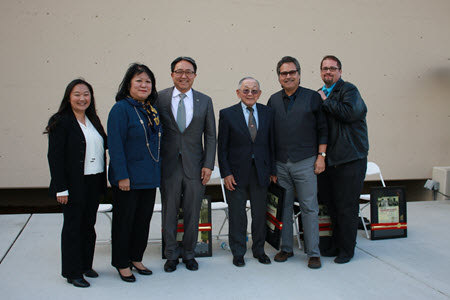
On April 13, a Day of Remembrance was held at Stanislaus State. Each of the speakers were quick to point out that any ceremony regarding Executive Order 9066 was not a call for celebration but a chance to learn about America’s national atrocity and to offer a moment to consider that this is a country in which all nationalities and religious groups should feel safe and welcome.
“President Roosevelt’s order led to the forced removal and incarceration of roughly 120,000 Americans of Japanese ancestry living on the West Coast,” Stan State President Ellen Junn reminded the audience in her opening remarks. “No Japanese Americans were ever even charged of espionage or sabotage against the United States. Yet they were imprisoned for years, simply for having what was considered to be the face of the enemy.”
Junn went on to point out that during the summer of 1942, the Stanislaus County Fairgrounds were used as a staging area for internees headed to the remote desert camp near Arizona’s Gila River — one of 10 internment camps hastily set-up by the U.S. government. A little more than 18 years later, those same fairground buildings housed the first Stanislaus State College classes.
The speakers who followed Junn: Cal State East Bay President Leroy Morishita, a child of internees; internee and Japanese American activist Sherman Kishi; Stan State History Professor Sam Regalado; and Stan State graduate and community college instructor David Seymour, all commented that many lessons Americans should have learned from that dark chapter have yet to be absorbed.
“After hearing my parents tell me their internment story for the first time when I was 18, I couldn’t fathom what was going on in their minds during those times,” Morishita said. “I couldn’t understand how this could have happened in our country with our freedoms. But even now we see a movement to ostracize Muslims, or ban other people on ethnic, religious or sexual grounds. We have to take the lesson we learned from Executive Order 9066 and try to make sure nothing like this ever happens again.”
Kishi, who was 17 and an outstanding student at Livingston High School when his family was forced to relocate, went on to volunteer his service to the U.S. military as an interpreter and translator, and in 2011 was awarded the Congressional Gold Medal for his work within the 442nd Regimental Combat Team.
“Prior to Pearl Harbor, there was a commission sent out by the government to check on the loyalty of Japanese ancestry,” Kishi said. “This commission reported in October 1941 that the second-generation Japanese — my generation — were a very loyal group, and that the first generation would be no problem to the U.S. government. The FBI concluded the same thing.
“In spite of this, EO 9066 was signed and we were put into these camps. Some people call them internment camps. I call them concentration camps, because every one of them had barbed wire and every one had guard towers all around.”
Regalado, who has taught and written about the experiences of Japanese Americans, sent a warning about the dangers of forgetting the internment camps.
“The Supreme Court gave its blessing to Executive Order 9066, stating that it was reasonable to believe the incarceration of Japanese Americans was in the best interest of our national security, never mind that there was no evidence of sabotage or unpatriotic activity among the Nikkei people,” Regalado said. “While we properly commemorate the Day of Remembrance, let’s not equate commemoration with celebration. Executive Order 9066 was a stain on our noble history.”
Seymour was part of the group that successfully advocated for a permanent marker at the Stanislaus County Fairgrounds to commemorate the internment assembly center. The marker was unveiled in 2010, but as Seymour pointed out, the process of raising money was not always smooth, even 65 years after the end of World War II.
“This was a grassroots movement for donations and we were touched at how many people wanted to donate,” Seymour said. “But we also received nasty phone calls and hate-filled letters saying we were un-American. That was disturbing and we decided to not pay attention to the ignorant and pernicious.”
The outdoor ceremony included a performance from the Ballico Taiko youth drum group and concluded in the University Art Gallery, where Special Collections and Digital Archives Librarian Laura French led a discussion on the World War II era collection housed at the Vasche Library, “The Turlock Social Club and Executive Order 9066.” The collection will remain on display at the University Art Gallery until April 28.
The entire day, from the performance, to the speeches, to the reception, was arranged to make sure none of the attendees ever would forget that America once chose to imprison its own citizens simply because of their country of origin.
“Now, our leaders and supporters besmirch people who they find to be undesirable, untrustworthy or dangerous — justification often based on fiction,” Regalado said. “Policies are being created to discriminate against people for what they are as opposed to what they’ve done. It’s in this environment that we find out if the Day of Remembrance has taught us anything.”